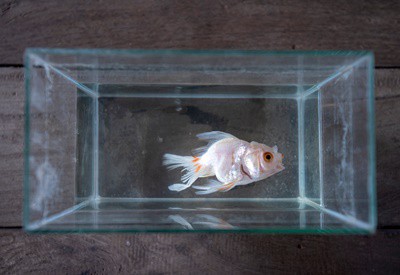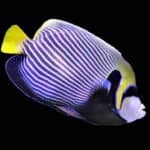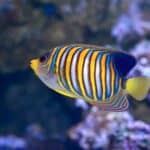If you notice your fish turning white and dying, this could be for various reasons. It’s normal for fish to change color as they die, but this can signify a health or environmental issue.
When fish turn white, it’s usually due to low oxygen levels in the tank.
Other causes of loss of color are poor water quality and overcleaning. Fish lose color when they’re close to death due to a lack of oxygen or nutrients, air not circulating, and the inability to absorb sunlight.
Monitor the fish’s coloration, especially if it happens before they die. Any changes to their appearance can indicate that something within the tank isn’t right.
Why Do Fish Turn White When They Die?
When a fish dies, it no longer has air, light, or nutrients circling its body, causing it to become white. Also, as soon as the fish dies, it begins to rot, hence why it turns white so fast.
However, a dead fish turning white sometimes indicates that your water parameters or tank positioning aren’t optimal, putting your surviving fish at risk.
Several factors determine a fish’s coloration, including:
Water Quality Fluctuations
Poor water quality is one of the primary reasons for fish turning white and dying.
Fish have specific water requirements – the pH and water temperature must be optimal for survival. It varies depending on the species, but this is something that all fish have in common.
Most tropical fish thrive with a pH of between 6.8 to 7.8. Goldfish and other cold-water species require the water’s pH to be between 7.0 to 8.4. Similarly, rapid water changes can be harmful or fatal.
Several things can cause the pH levels to become unbalanced, including:
- Trace mineral content.
- The type of substrate in the tank.
- The chemical concentration of the water.
- Failure of the filtration system.
- Too many driftwood decorations.
- Certain medications.
If any of these things cause the pH levels to drop or the water conditions to become unsanitary, your fish will turn white and die due to the exposure.
There are things you can do to restore your aquarium’s pH, including:
- Carrying out a water change to restore the tank’s natural pH balance.
- Changing your substrate.
- Increasing the aeration.
- Add a small amount of baking soda to the water.
Then, monitor the rest of your fish to ensure the survivors don’t turn white or become discolored.
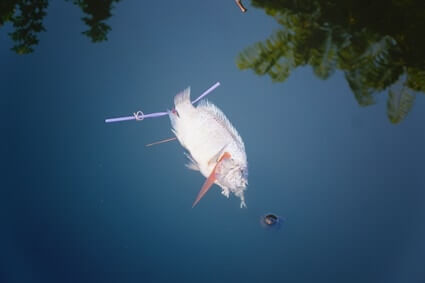
Tank Overcleaning
Cleaning your fish tank is essential because it:
- Removes waste, such as ammonia, nitrites, and nitrates.
- Prevents unwelcome growth.
- It keeps the filter functioning correctly.
Fish need their tanks cleaned once or twice a month. Depending on how often you clean your tank, aim to replace 10-20% of the water in one go. Avoid changing more than 40% of the water in one sitting, as this can cause problems for the tank and the fish in it.
However, cleaning the tank too frequently causes your fish to become stressed out. Not only will this turn them white or dull in coloration, but it can lead to an early death.
If you replace too much water at once or too often, the beneficial bacteria that had previously built up within the tank will die.
It’ll mean that your fish has to undergo the cycling process to re-add bacteria. Without them, ammonia and nitrites will overpopulate the tank, causing your fish to get sick.
Nutritional Deficiencies
Your fish’s diet plays a large part in coloration maintenance.
While fish have different nutritional requirements, they need a high-quality, specialized diet with the proper nutrients to stay healthy.
Most fish flakes and pellets are specially formulated to provide each fish species with the things they need. However, some need a selection of the following:
- Fresh fruits and vegetables.
- Plant matter.
- Insects.
- Worms.
You must research the nutrients your fish require and choose compatible species for your community tank to ensure they’re not getting the wrong types of foods. When different fish are in one tank, they cannot separate their food.
Nutritional deficiencies are responsible for turning your fish white and will cause them to die. The Pet Food Manufacturers Association explains that most fish require:
- Protein, which supplies the ten amino acids they need.
- Fat is necessary for energy and a source of essential unsaturated fatty acids.
- Vitamins, including A, C, D, E, and K.
- Minerals like calcium, phosphorus, iron, iodine, and magnesium.
Some fish foods contain pigment enhancers, which bring out the natural colors of the fish. These enhancers include shrimp meal, Spirulina algae, and lutein.
As soon as a fish stops eating and dies, its colors fade. Some fish become dull, while others turn white. It depends on how long the individual fish stopped eating before its death.
Poor Oxygen Levels
Once a fish dies, the blood and organs stop receiving O2, and the body quickly loses its once-vibrant coloring. This is an entirely natural process and shouldn’t cause any concern.
However, a fish turning translucent white before it dies indicates insufficient oxygen in the tank, suggesting the fish died of suffocation.
Signs of insufficient oxygen include:
- Gasping at the surface.
- Moving less.
- Appetite loss.
- Labored breathing.
However, you can increase the aquarium’s oxygen levels, including the following:
- Carry out a significant water change, replacing 60% of the water.
- Add more plants.
- Provide substrate that allows plants to grow.
- Increase your tank’s surface area.
- Increase surface agitation.
- Decrease the number of fish you have.
A lack of oxygen also leaves them susceptible to health conditions.
Lack of Sunlight
Fish need some sunlight to stay productive and healthy. Some fish species, such as koi and goldfish, need the sun to develop healthy skin pigmentation.
If fish don’t get enough natural sunlight, their scales appear lighter and fade over time. Similarly, fish kept in the dark are at risk of turning white altogether. This isn’t something that only happens when fish die, as their scales can fade at any time without the right lighting conditions.
To prevent this from happening, put your tank where it can receive up to 12 hours of natural sunlight a day. However, don’t place it in direct sunlight, as it’ll increase the water temperature and wreak havoc on the ecosystem. Filtered light is always recommended.
Artificial Light
Bright artificial lights are responsible for fading your fish’s scales.
As described by Science Direct, light that’s too intense can also be stressful, which is another primary cause of whiteness in fish.
Aquarium lights are used to:
- Keep fish healthy.
- Help plants grow.
- Allow owners to see their fish.
- Illuminate the fish’s colors.
However, you shouldn’t have the lights too bright as they should replicate natural lighting conditions if you don’t have access to natural sunlight. Similarly, fish sleep at night, so turn them off when you go to bed to allow this and preserve your fish’s scale coloration.
Stress
When fish get stressed, it shows on their scales. It’s easy to tell when something’s wrong because their scales become dull and colorless.
Overly stressed fish eventually die, and when they do, you’ll notice they appear white rather than bright and vibrant. This indicates your fish were mentally unwell when they died.
One of the most common causes of stress in fish is aggressive behavior from other tankmates. Their scales will become dull if they’re continually chased and harassed by other fish, and the more stressed your fish are, the quicker they’ll lose their colors.
The other main signs of stress include:
- Frequent hiding.
- Glass surfacing.
- Jumping out of the tank.
- Fin rot.
- Loss of appetite.
- Constant sickness.
When it comes to your fish’s appearance, you might notice:
- Dimmer colors that appear dull and lifeless.
- Fins that seem ashy or thin.
- Scales that appear flaky or frail.
- Stripes that fade away or appear faded in color.
Illnesses
Sick fish lose their color, but how much so depends on the species and the type of illness. If one of your fish suffers from a disease that’s entered the advanced stages, it’ll experience significant changes to its appearance, and the color will drain from its scales rapidly.
It’s not easy to tell when your fish is sick, so observe for any of these signs:
- A lack of appetite.
- Holes, bulges, or spots.
- Protruding or lost scales.
- The fish get attacked by other fish in the tank.
- Torn fins.
- Unusual swimming patterns.
These are common indicators that your fish is close to death. If it’s already died and appears white, monitor the healthy fish in case of a contagious condition.
Infections
Fish are commonly prone to bacterial, fungal, viral, parasitic, and protozoal infections. Unfortunately, these things are easily transmitted to other fish, putting the entire tank at risk. Poor water quality and rising chemicals are likely to worsen the problem.
The most common infections include:
Some infections cause fish to lose their scales. This is an extreme reaction, but it indicates that the fish are in the advanced throes of illness. Also, it explains why your fish turned white and died.
Age and Genetics
It’s common for fish to lose their color as they get older.
Genetics play a significant part in this, determining whether fish stay bright and colorful or fade over time. Some cells don’t live as long as others, so it’s natural for fish to fade to white before they die.
Why Do Fish Change Color When They Die?
Not all fish turn white when they die: some go from bright to dull, while others change color altogether. Environmental factors are usually to blame.
Like fish turning white, poor water conditions and unsuitable parameters can unexpectedly transform your fish’s scales. Stress is also a likely explanation.
Several things can cause stress, including the following:
- Problems with other fish.
- Unsuitable water temperature.
- Dirty water.
- Lack of hiding places.
- Poor diet.
Stressed fish are unhealthy fish and are a leading cause of death. Even though it’s not always easy to tell when something’s wrong within the tank, paying attention to your fish’s demeanor and regularly testing the water will help preserve your fish’s coloration.
What Does a Fish Look Like When It’s Dead?
It’s relatively obvious to determine when a fish has died. Not only does it stop moving, but it’ll look different from the rest of the fish.
It’s not pleasant to see a dead fish floating in the tank, but knowing what one looks like can enable you to diagnose death when the time comes.
You can check that the fish is dead by paying attention to the following:
Sunken Eyes
When fish die, their eyes become sunken, which is one of the most obvious signs that they’re dead.
Similarly, when you remove the fish from the water, they’ll stare motionless without moving. If the pupils rotate downward, the fish is still alive, and you need to put it back into the water.
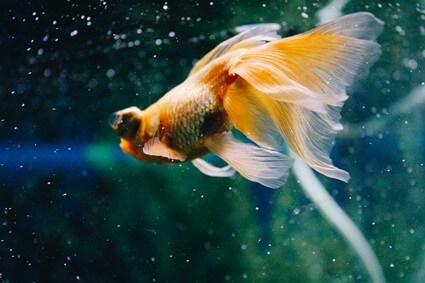
Cloudy Pupils
Some fish species, such as pufferfish, walleye, and scorpionfish, develop cloudy eyes after death. Similarly, if your fish had been in poor health before death, it would die with milky eyes.
Such health issues include:
- Dietary deficiencies, specifically a lack of vitamin A.
- Poor water quality.
- Ammonia poisoning.
- Cancer.
Did the fish develop cloudy eyes and a white-scaly appearance? If so, it was due to a health problem or unsuitable water conditions.
Stiff Body
A dead fish should be stiff due to Rigor Mortis setting in. If your fish feels soft and floppy when you scoop it out of the water, it’s likely still alive, or it might have just died.
Fish that have died after jumping out of the tank will have cracked, dried bodies due to dehydration, and some scales might fall off.
Lack of Pigmentation
Dead fish lose their pigmentation due to a lack of nutrients, oxygen, air, and light. This is why you’ll notice your fish looking white or dull.
Unhealthy or stressed fish are unlikely to have full coloration, so it’s normal to see dead fish looking dull and colorless.
Floating on the Surface
Smaller dead fish, such as guppies and tetras, float. Larger ones, like cichlids, are more likely to sink to the bottom of the tank, and that’s where you’ll find them when you inspect the tank.
However, if your fish has been dead for a while, gasses will build up, causing it to rise to the surface. Also, this will give them a bloated, rounded appearance.
While it’s normal for fish to lose color and die, it’s abnormal if the living fish start turning white or dull. There are so many factors that can contribute to this, but you can determine the issue.

